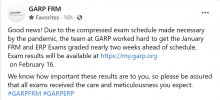We hope that everyone did well on the FRM Part 2 exam on Saturday!  We would love to hear any feedback that you have about the exam. How did it go? Did you encounter unexpected questions? How was the experience with all of the new COVID guidelines? Thank you in advance for any feedback you can provide!
We would love to hear any feedback that you have about the exam. How did it go? Did you encounter unexpected questions? How was the experience with all of the new COVID guidelines? Thank you in advance for any feedback you can provide!
 We would love to hear any feedback that you have about the exam. How did it go? Did you encounter unexpected questions? How was the experience with all of the new COVID guidelines? Thank you in advance for any feedback you can provide!
We would love to hear any feedback that you have about the exam. How did it go? Did you encounter unexpected questions? How was the experience with all of the new COVID guidelines? Thank you in advance for any feedback you can provide!
Last edited:

 ) and everyone else in the BT community for the prep materials, videos and discussions on this forum. I used Kaplan/Schweser for part 1 in 2019, but am happy to have switched to BT for part 2.
) and everyone else in the BT community for the prep materials, videos and discussions on this forum. I used Kaplan/Schweser for part 1 in 2019, but am happy to have switched to BT for part 2.

